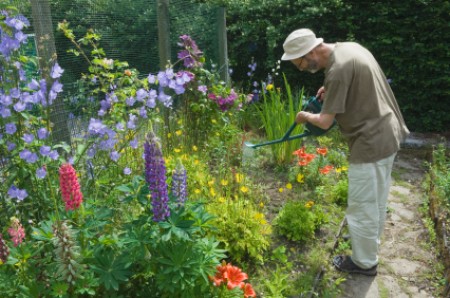
To keep your perennial flowers healthy and looking their best all season long, you need to get in the habit of scheduling some routine maintenance. Here are some strategies for upkeep that require minimal effort, allowing you to spend more time enjoying your garden, and less time working in it.
Applying mulch is the single most effective way to save time and money in the garden. A few inches of organic mulch suppresses weeds, conserves water, helps maintains an even soil temperature, and adds a valuable layer of organic matter to the soil. Early in the season, choose organic mulch like chopped leaves, straw, pine needles, grass clippings, or shredded bark. Apply a few inches of mulch around plants leaving about an inch of space around the stem of each plant. If your mulch begins to break down and starts to look thin during the season, add a little more.
Make the phrase "more water, less often" your mantra for watering your perennial garden. Shallow watering makes for shallow roots, and when the soil surface dries out, so do the roots. Instead, allow water to soak deep into the soil. This encourages roots to grow deeper, which reduces the need for frequent watering. It's also helpful to build a rim of soil around plants to create a saucer-like depression that holds water. Perennials need watering most during the following times and in the following situations:
Keep the need for fertilizing to a minimum by starting with healthy soil. Beyond that, a light fertilization program is usually more than enough to carry perennials through the growing season. Use a high phosphorus organic fertilizer (e.g. 5-10-5) at 4 to 6 week intervals (or according to package directions) to promote healthy stems and flowers. Always water after applying fertilizer to clean fertilizer from the foliage and reduce the risk of burn. There are two basic types of fertilizers: granular fertilizers and water-soluble fertilizers. Granular fertilizers are usually slow-releasing - they feed plants slowly over a long period to time. Water-soluble fertilizers produce quicker results by rapidly releasing all of their nutrients. Either type is fine, but a granular fertilizer will require fewer applications (less maintenance!)
The easiest way get garden chores done in a timely fashion is to set up a schedule. A simple wall calendar will work well for managing your "to-do" lists and it's also a nice way to record what is happening in your garden (e.g. last frosts, first flowers, bird species, etc.) Don't worry about sticking to a rigid schedule. Nature is dynamic and forgiving. If you have to leave town for a week or two, your garden chores will happily wait until you get back.
Take a few minutes each day to walk outside and enjoy your flower beds. Once each week, take along a bucket with a hand trowel, scissors, and a pair of pruning shears and spend a few minutes taking care of some routine tasks:
In addition to your weekly gardening chores, a few jobs need attention once a month. You can work these tasks into your weekly routine, or allow yourself a little extra time once a month.

About The Author: Ellen Brown is an environmental writer and photographer and the owner of Sustainable Media, an environmental media company that specializes in helping businesses and organizations promote eco-friendly products and services.
Add your voice! Click below to comment. ThriftyFun is powered by your wisdom!